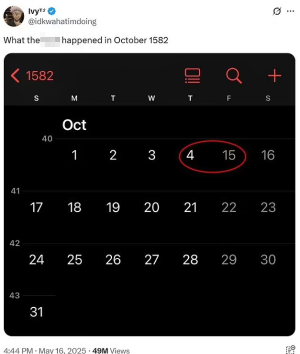Is Your iPhone Hiding 10 Days From You? The Surprising Calendar Glitch Everyone’s Talking About
By
Gian T
- Replies 5
If you’ve ever found yourself idly scrolling through your iPhone’s calendar—perhaps out of curiosity, boredom, or just to see how far back you can go—you might have stumbled upon a rather odd discovery: in the year 1582, the calendar jumps straight from October 4 to October 15. That’s right, ten days simply vanish into thin air!
This strange omission has left social media users scratching their heads, with some jokingly wondering if we’re all ten days older than we think, or if Apple is playing some sort of elaborate prank. But before you start worrying about lost birthdays or missed anniversaries, let’s dive into the real reason behind this historical hiccup—and why your iPhone (and every other modern calendar) is actually spot on.
The Viral Discovery That Sparked Confusion
It all started when a sharp-eyed iPhone user scrolled back to 1582 and noticed the missing days. Their post quickly went viral, racking up millions of views and thousands of comments. Some users joked, 'They’ve been keeping us 10 days behind!' while others quipped, 'Someone got knocked into next week—literally.'
A few even wondered how bored you’d have to be to scroll back over 500 years in your calendar app! But as it turns out, this isn’t a tech glitch or a secret Apple Easter egg. The answer lies in a fascinating chapter of history that changed the way the entire world keeps time.
The Real Reason: A Calendar Correction Centuries in the Making
To understand why those ten days are missing, we need to travel back to ancient Rome. In 45 BC, Julius Caesar introduced the Julian Calendar, a system that was a huge improvement over previous methods but still had a tiny flaw: it was about 11 minutes and 14 seconds longer than the actual solar year. That might not sound like much, but over centuries, those minutes add up, causing the calendar to drift out of sync with the seasons.
By the 1500s, this drift had become a real problem—especially for the Catholic Church, which relied on the calendar to determine the date of Easter. The spring equinox, which was supposed to fall on March 21, was slowly creeping earlier and earlier.
Enter Pope Gregory XIII. In 1582, he decided enough was enough and introduced the Gregorian Calendar—the very system we use today. To get things back on track, the Pope simply *deleted* ten days from the calendar. So, in countries that adopted the new system, people went to bed on October 4, 1582, and woke up on October 15. Imagine missing ten days of rent or skipping your own birthday!
Why October?
You might wonder, why did they choose October for this time jump? The answer is surprisingly practical: October was a relatively quiet month in the Church calendar, with no major religious holidays that would be disrupted by the missing days. This made the transition a little less chaotic for everyone involved.
A Patchwork of Dates Across the World
Of course, not everyone switched to the new calendar at the same time. Catholic countries like Italy, Spain, and Portugal made the change in 1582, but Protestant and Orthodox countries took much longer. The British Empire (including Australia, by extension) didn’t adopt the Gregorian Calendar until 1752—by which time the gap had grown to 11 days! For centuries, travelling across Europe could mean jumping forward or backward in time, depending on which country you were in.
Fun Facts: How the Calendar Change Affected Everyday Life
- Missed Birthdays and Anniversaries: Some people did, in fact, miss their birthdays or other important dates. There are even stories of people protesting, demanding their 'lost' days back!
- Rent and Wages: In some places, landlords tried to charge a full month’s rent, even though the month was ten days shorter. Not surprisingly, tenants weren’t too happy about that.
- Historical Confusion: Historians have to be careful when reading old documents, as dates before and after the switch can be confusing. You might see 'Old Style' (Julian) and 'New Style' (Gregorian) dates in the same year.
Why Your iPhone (and Google Calendar, and Outlook…) Still Shows the Missing Days
Modern digital calendars are designed to reflect historical reality, not just the present. That’s why, if you scroll back to 1582, you’ll see the same ten-day gap on your iPhone, your computer, or even a printed calendar that covers those years. It’s a little nod to the quirks of history—and a reminder that even something as simple as a calendar can have a fascinating backstory.
What Does This Mean for You?
Unless you’re planning to schedule a meeting in 1582 (and if you are, we’d love to hear about it!), this missing week and a half won’t affect your day-to-day life. But it’s a great conversation starter, and a fun bit of trivia to share with friends and family. Next time someone complains about a 'glitch' in their phone, you can impress them with your knowledge of the Gregorian reform!
Final Thoughts
So, the next time you’re scrolling through your iPhone calendar and notice those missing days in October 1582, you can rest easy knowing it’s not a bug—it’s a feature! A fascinating reminder of how our ancestors literally 'lost' ten days to keep the world running on time.
Who knew a simple calendar app could open a window into one of history’s greatest timekeeping shake-ups?
Credit: X
 We’d love to hear from you! Have you ever spotted a strange quirk in your phone’s calendar or stumbled across a bit of history hiding in plain sight? Share your stories and questions in the comments below—let’s see what other time-travel mysteries we can uncover together!
We’d love to hear from you! Have you ever spotted a strange quirk in your phone’s calendar or stumbled across a bit of history hiding in plain sight? Share your stories and questions in the comments below—let’s see what other time-travel mysteries we can uncover together!
This strange omission has left social media users scratching their heads, with some jokingly wondering if we’re all ten days older than we think, or if Apple is playing some sort of elaborate prank. But before you start worrying about lost birthdays or missed anniversaries, let’s dive into the real reason behind this historical hiccup—and why your iPhone (and every other modern calendar) is actually spot on.
The Viral Discovery That Sparked Confusion
It all started when a sharp-eyed iPhone user scrolled back to 1582 and noticed the missing days. Their post quickly went viral, racking up millions of views and thousands of comments. Some users joked, 'They’ve been keeping us 10 days behind!' while others quipped, 'Someone got knocked into next week—literally.'
A few even wondered how bored you’d have to be to scroll back over 500 years in your calendar app! But as it turns out, this isn’t a tech glitch or a secret Apple Easter egg. The answer lies in a fascinating chapter of history that changed the way the entire world keeps time.
The Real Reason: A Calendar Correction Centuries in the Making
To understand why those ten days are missing, we need to travel back to ancient Rome. In 45 BC, Julius Caesar introduced the Julian Calendar, a system that was a huge improvement over previous methods but still had a tiny flaw: it was about 11 minutes and 14 seconds longer than the actual solar year. That might not sound like much, but over centuries, those minutes add up, causing the calendar to drift out of sync with the seasons.
By the 1500s, this drift had become a real problem—especially for the Catholic Church, which relied on the calendar to determine the date of Easter. The spring equinox, which was supposed to fall on March 21, was slowly creeping earlier and earlier.
Enter Pope Gregory XIII. In 1582, he decided enough was enough and introduced the Gregorian Calendar—the very system we use today. To get things back on track, the Pope simply *deleted* ten days from the calendar. So, in countries that adopted the new system, people went to bed on October 4, 1582, and woke up on October 15. Imagine missing ten days of rent or skipping your own birthday!
Why October?
You might wonder, why did they choose October for this time jump? The answer is surprisingly practical: October was a relatively quiet month in the Church calendar, with no major religious holidays that would be disrupted by the missing days. This made the transition a little less chaotic for everyone involved.
A Patchwork of Dates Across the World
Of course, not everyone switched to the new calendar at the same time. Catholic countries like Italy, Spain, and Portugal made the change in 1582, but Protestant and Orthodox countries took much longer. The British Empire (including Australia, by extension) didn’t adopt the Gregorian Calendar until 1752—by which time the gap had grown to 11 days! For centuries, travelling across Europe could mean jumping forward or backward in time, depending on which country you were in.
Fun Facts: How the Calendar Change Affected Everyday Life
- Missed Birthdays and Anniversaries: Some people did, in fact, miss their birthdays or other important dates. There are even stories of people protesting, demanding their 'lost' days back!
- Rent and Wages: In some places, landlords tried to charge a full month’s rent, even though the month was ten days shorter. Not surprisingly, tenants weren’t too happy about that.
- Historical Confusion: Historians have to be careful when reading old documents, as dates before and after the switch can be confusing. You might see 'Old Style' (Julian) and 'New Style' (Gregorian) dates in the same year.
Why Your iPhone (and Google Calendar, and Outlook…) Still Shows the Missing Days
Modern digital calendars are designed to reflect historical reality, not just the present. That’s why, if you scroll back to 1582, you’ll see the same ten-day gap on your iPhone, your computer, or even a printed calendar that covers those years. It’s a little nod to the quirks of history—and a reminder that even something as simple as a calendar can have a fascinating backstory.
What Does This Mean for You?
Unless you’re planning to schedule a meeting in 1582 (and if you are, we’d love to hear about it!), this missing week and a half won’t affect your day-to-day life. But it’s a great conversation starter, and a fun bit of trivia to share with friends and family. Next time someone complains about a 'glitch' in their phone, you can impress them with your knowledge of the Gregorian reform!
Final Thoughts
So, the next time you’re scrolling through your iPhone calendar and notice those missing days in October 1582, you can rest easy knowing it’s not a bug—it’s a feature! A fascinating reminder of how our ancestors literally 'lost' ten days to keep the world running on time.
Who knew a simple calendar app could open a window into one of history’s greatest timekeeping shake-ups?
Credit: X
Key Takeaways
- Social media users were baffled to discover the iPhone calendar skips 10 days in October 1582, jumping straight from the 4th to the 15th.
- The missing days are due to the historical switch from the Julian to the Gregorian calendar, ordered by Pope Gregory XIII to correct astronomical errors.
- This calendar change meant many people in 1582 went to bed on October 4 and woke up on October 15, losing 10 days overnight.
- Online reactions ranged from confusion and conspiracy jokes to history buffs delighting in seeing a centuries-old reform play out on a modern iPhone.








